Chesterfield, Derbyshire
Up to 1834
A parish workhouse was erected in Chesterfield in 1735-7 on the south side of the Bowling Green at the south of the Market Place.
In 1767, forty-two Derbyshire parishes (some of whom would later form part of the Chesterfield Poor Law union) voluntarily formed themselves into the Ashover Union. The Union bought a large former bath-house at Ashover for use as a joint workhouse.
A parliamentary report of 1777 recorded local workhouses in operation at Chesterfield (for up to 50 inmates), Ashover (60), Barlow (10), Dronfield (12), and Eckington (36).
Eden, in his 1797 survey of the poor in England, reported of Chesterfield that:
In 1832, Assistant Poor Law Commissioner Mr R Pilkington investigated the operation of the poor laws in Derbyshire. He noted that Chesterfield had a "a commodious workhouse" and criticised the town for providing relief to the able-bodied without work being demanded. The salaried Assistant Overseer of Chesterfield, Mr Gratton, reported that the workhouse was occupied only by old people and children whose maintenance cost an average of 3s.5d. a week. According to local Justice of the Peace, Edward Maynard, "there is no work on which to employ paupers except occasionally sweeping the streets and running errands."
After 1834
Chesterfield Poor Law Union formally came into existence on 19th October 1837. Its operation was overseen by an elected Board of Guardians, 40 in number, representing its 34 constituent parishes as listed below (figures in brackets indicate numbers of Guardians if more than one):
Derbyshire:
Ashover (2), Great Barlow, Little Barlow, Bolsover, Brackenfield, Brampton, Brimmington, Calow, Chesterfield (3), Clayalne, Coal Aston, Dronfield, Eckington (2), Hasland, Heath, Holmesfield, Killamarsh, Morton, Newbold and Dunston, Normanton Temple, Pilsley, Shirland and Higham, Staveley (2), Stretton, Sutton-cum-Duckmanton, Tapton, Tupton, Unstone, Walton, Wessington, Whittington, Wingerworth, North Wingfield, Woodthorpe.
Later Additions (from 1894): Dronfield Woodhouse, Egstow.
The population falling within the Union at the 1831 census had been 34,246 — ranging from Little Barlow (population 58) to Chesterfield itself (5,575). The average annual poor-rate expenditure for the period 1836-38 had been £8,874 or 5s.2d. per head of the population.
The new Board of Guardians held its inaugural meeting on 20th October in Chesterfield Town Hall. The Officers elected were: Robert Arkwright as Chairman, EG Maynard and Gilbert Crompton as Vice-chairmen, and John Marsh as Clerk. Richard Crompton was also appointed Treasurer. The Board decided that the existing Chesterfield parish workhouse would be adequate for the immediate needs of the Union. It was reported to be capable of accommodating 100 but had rarely been more than a third full. It was therefore decided to rent it temporarily from the Chesterfield Overseers at £50 per annum.
During the next few months, supplies for the old workhouse included 48 brown chamber pots, 30 iron bedsteads each costing 28s.6d, and bedding for each comprising a mattress (6s.), a pair of blankets (11s.), and a pair of sheets (4s.5d).
Plans were also proceeding for a new workhouse for 300 inmates which the Guardians hoped would be:
a good and efficient workhouse which shall not have the appearance of either a prison or a palace and which shall be an asylum for the aged, the helpless and the infirm, while at the same time it shall hold out no inducement to the idle and profligate to enter with its walls. (Bestall, 1978)
In November 1837, land on Newbold Road opposite Trinity Church was purchased for £700 from Joseph Gratton. The architects appointed were the prolific partnership of George Gilbert Scott and William Bonython Moffatt who were also responsible for the workhouse at Belper. Scott and Moffatt's design for Chesterfield was similar to their one at Boston and they showed the Guardians a wooden model of their proposed building. However, to reduce costs, the Guardians visited new workhouses at Belper, Burton on Trent, Derby and Mansfield and a number of changes were made to the plans including the omission of a block for "idiots" and "imbeciles". The final cost of building and fitting out the workhouse was around £10,000. The builders, Wilson and Knight of Radford, had contracted to carry out the construction work for the sum of £6,245. However, their tender presumably underestimated the cost of the work and they went bankrupt in the process. The new building received its first inmates on December 9th 1839.
The layout of the new workhouse can be seen on the 1880 map below.
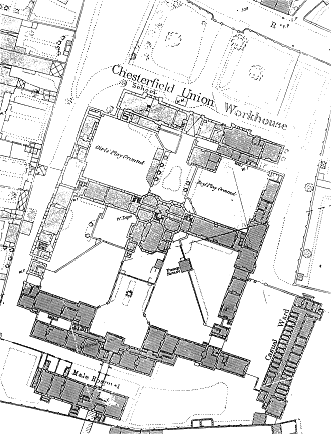
Chesterfield workhouse site, 1880.
Chesterfield was typical of Scott and Moffatt's workhouse designs. At the north, a single storey entrance block with a central entrance archway faced onto Newbold Road. This block contained the porter's lodge, the Guardians' board room, clerk's office, receiving wards and so on. The western side of the entrance block contained two large rooms, one of which was a school room and may also have served as a chapel.
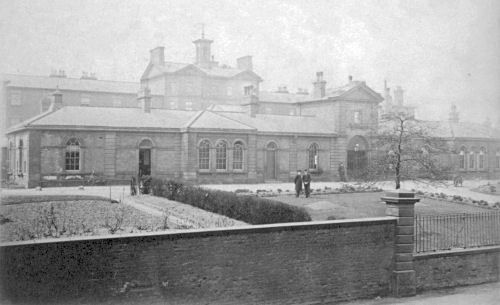
Chesterfield workhouse from the north-east
To the rear of the entrance block stood the three storey main accommodation block, the area in between being divided into boys' and girls' walled playgrounds either side of a central thoroughfare. The main block would have contained the master and matron's quarters at its centre, with men's accommodation to the east and women's to the west.
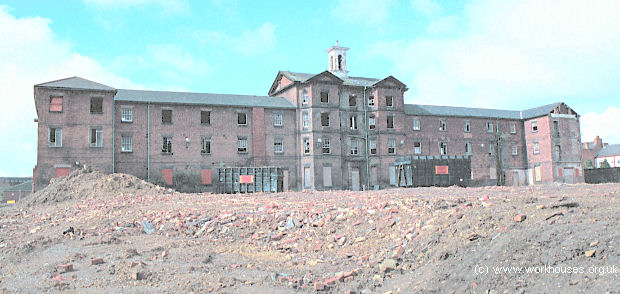
Chesterfield main block from the north, 2001.
© Peter Higginbotham.
A U-shaped infirmary stood at the rear of the site, flanked by various single storey buildings at each side, with a laundry on the women's side, and workshops on the men's. The work performed in the workhouse included limestone breaking, oakum picking and bone grinding.
A number of other buildings were added over the years, including several infirmary blocks, a nurses' home, and casual wards at the south-east of the site.
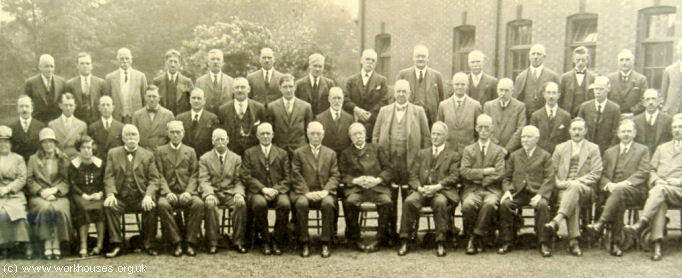
Chesterfield Board of Guardians and Rural District Council members, 1929.
© Peter Higginbotham.
In August 1866, the workhouse received a visit from Poor Law Inspector R.B.Cane. His report was less than favourable.
I found the hospital or infirmary in a very unsatisfactory state. There was no proper supply of water in the water-closets.
Some of the beds were placed so near together as almost to touch.
The rain was dripping through the ventilators in the ceiling on to the floors, and in one instance on to a bed.
The chimney in one of the wards was smoking violently, and so as to be utterly destructive of all comfort in the ward.
Long wooden forms, without backs, are used instead of chairs, although some chairs are provided.
There are no proper dining tables in some of the wards. Table cloths are not used.
In one ward there were seven small children eating their dinners on the floor. They were in a dirty, neglected, and discreditable condition.
The medicines are not given by the nurse. The bottles, &c., are handed over to the patients themselves, who take the contents or not as they are inclined. There is therefore no security that the medicines, &c., are taken at all, or, if taken, that they are taken by the proper persons, at the proper times, and in the prescribed quantities.
There are no proper means for washing the persons of the sick in these wards.
There is only one towel allowed for use in each ward in a week.
There are no proper hand basins. The women use their chamber utensils for washing purposes.
Altogether this infirmary was in a disorderly, uncleanly, cheerless, and comfortless condition.
There is no stove for purifying and disinfecting clothes in this workhouse.
The workhouse later became Chesterfield's Scarsdale Hospital. The site was redeveloped in 2001 and all the buildings demolished except for the main block.
Chesterfield Union Industrial Schools / Ashgate Homes
In 1880-81 the Chesterfield Board of Guardians erected children's "Industrial Schools" on Ashgate Road, Brampton. The eleven acre site was purchased for £2,500 from the Chesterfield Charity Trustees. The buildings, constructed in red pressed brick with stone dressings, were designed by the local firm of Rollinson and Son and their construction cost £12,600. The site is shown on the 1921 map below.
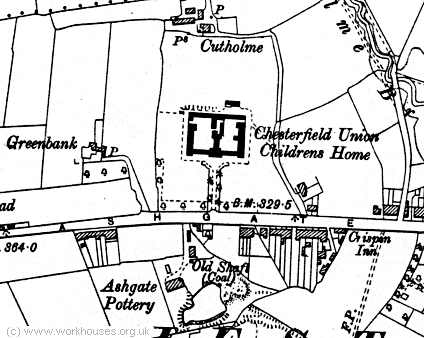
Chesterfield Children's Home site, 1921.
The buildings comprised a central administrative department linked by covered walkways to the boys' and girls' blocks at either side.

Chesterfield Children's Home, c.1905.
During the First World War, the homes were evacuated and the premises occupied by the Lancashire Regiment.
In 1930, the Ashgate Homes, as they was also became known, were taken over by Derbyshire County Council and continued in use as a children's home until around 1936. The buildings no longer exist.
Staff
Inmates
Records
Note: many repositories impose a closure period of up to 100 years for records identifying individuals. Before travelling a long distance, always check that the records you want to consult will be available.
- Derbyshire Record Office, New Street, Matlock, Derbyshire. Holdings include: Guardians' minute books (1837-1930); Admissions and discharges (1838-1946); Births (1847-1914); Deaths (1838-1904); Offences and punishments (1914-48); Register of seclusion and restraint (1914-48); Boarding-out Committee (1910-30); Children's Homes Committee (1912-30); etc.
Bibliography
- History of Chesterfield (Vol 3) by JM Bestall (Borough of Chesterfield, 1978)
- The Chesterfield Union Workhouse, 1839-47 by A Watson (in Journal of the Bakewell and District Historical Society, VIII, 1981).
Links
- None.
Unless otherwise indicated, this page () is copyright Peter Higginbotham. Contents may not be reproduced without permission.


